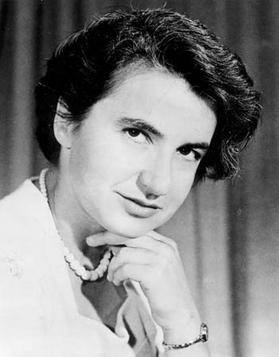Rosalind Franklin was a contemporary of the British nutritionist Elsie Widdowson and the Austrian physicist Lise Meitner.
Like Mary Anning, the English paleontologist who discovered the first ichthyosaur and plesiosaur skeletons, and dinosaur coprolites, Rosalind had many difficulties in researching and publishing because she was a woman. In both cases, their male colleagues used the findings of both to achieve success in their investigations. In the case of Mary Anning, she could not publish her findings because she was a woman and her name always appeared after a male name. In the case of Rosalind Franklin, her "photograph" was key to the discovery of the double helix, but the recognition went to Watson and Crick, who received the Nobel Prize.

Rosalind Elsie Franklin
London; 25-07-1920 — 16-04-1958
Period of activity: 1946 — 1958
Geographical classification: Europe > United Kingdom
Socio-cultural movements
Groups by dedication
Scientists > Biologists > Biophysicists
Scientists > Crystallographers
Writers > Journalists / Chroniclers > Literary, music, etc. critics
Context of feminine creation
Review
She has gone down in history for being the author of the famous Photograph 51, an image of the DNA molecule taken with a completely new technique at the time: X-ray diffraction. As both Watson and Crick recognized years later, the vision of the image taken by Rosalind Franklin was fundamental to the discovery of the structure of DNA.
Justifications
Biography
Rosalind Franklin was born into a Jewish family that had been banking for generations.
She studied chemistry at the University of Cambridge, despite the opposition of her father, who did not look favorably on a woman studying at university.
She worked in a chemical laboratory in post-war Paris and, in 1951, she began working for King's College London as an expert in X-ray crystallography. There she took an image of the DNA structure using X-ray techniques, which would be remembered as Photograph 51.
This photograph suggested a helical structure of DNA and was key to the determination of the Watson and Crick model. Both accessed to said photograph thanks to the fact that Maurice Wilkins, Rosalind's colleague, provided them with the image without the author's consent. Thanks to this, they won the Nobel Prize for the discovery of the structure of DNA, without admitting the crucial contribution of Flanklin until several years later.
Rosalind Franklin never realized the importance of her images, as she died of ovarian cancer at the age of 37, probably from using X-rays for many hours with little protection.
Works
Franklin, Rosalind Elsie (1950) “A rapid approximate method for correcting low-angle scattering measurements for the influence of the finite height of the X-ray beam”, Acta Crystallographica, nº 3, pp. 158-159
Franklin, Rosalind Elsie (1950) “A Influence of the bonding electrons on the scattering of X-rays by carbon”, Nature, nº 165 (4185), pp. 71-72
FRANKLIN, ROSALIND ELSIE (1951) “The structure of graphitic carbons”, Acta Crystallographica, 4, pp. 253-261
FRANKLIN, ROSALIND ELSIE & HOLMES, KENNETH (1956) “The helical arrangement of the protein sub-units in Tobacco Mosaic Virus”, Biochimica et Biophysica Acta, 21 pp. 405-406
Bibliography
Angulo, Eduardo. 2014. "El caso de Rosalind Franklin". Mujeres con Ciencia (July 2021)
< https://mujeresconciencia.com/2014/05/09/el-caso-de-rosalind-franklin/ >
Martínez Pulido, Carolina. 2016. "Recordando a Rosalind Frankiln". Mujeres con Ciencia (July 2021)
< https://mujeresconciencia.com/2016/04/25/5734/ >
BBC News, july 2021. < https://www.bbc.com/mundo/noticias-44225714 >
Wikipedia. July 2021. < https://es.wikipedia.org/wiki/Rosalind_Franklin >
Didactic approach
Biology and Geology 4º of ESO.